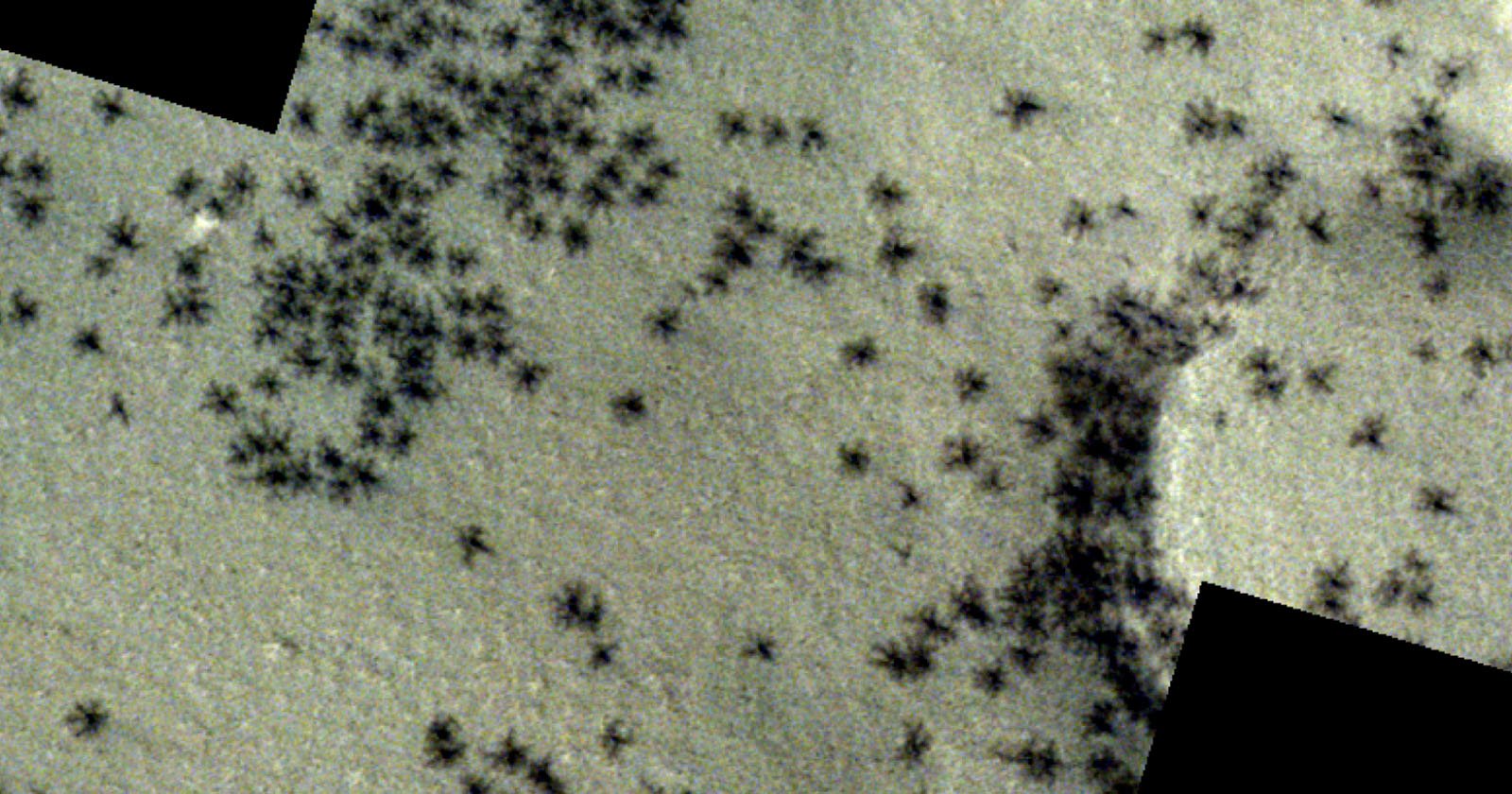A recent image captured by the European Space Agency’s (ESA) ExoMars Trace Gas Orbiter has sparked a frenzy of excitement, particularly among arachnophobes who might have done a double-take (or leaped back in horror) at the sight.
The image, hailing from the Martian southern polar region, depicts what appears to be a nightmarish scene of monstrous spiders sprawled across the rusty red plains.

However, trepidation can be cast aside – these are not denizens of an alien arachnid civilization, but rather a captivating geological phenomenon sculpted by the seasonal shifts on Mars.
Springtime Fountains: A CO2-Fueled Icequake
The spindly, dark patterns that weave across the Martian landscape are the result of a fascinating interplay between sunlight and carbon dioxide (CO2) ice. As the Red Planet plunges into its frigid winter, vast layers of CO2 ice accumulate on the surface, like a thick, frosty blanket. But as spring arrives, bathed in the gentle caress of the sun’s rays, a dramatic transformation unfolds. The icy grip loosens, and sunlight begins to penetrate the CO2 layers. This initiates a chain reaction – the CO2 at the bottom layer warms, transitioning from a solid state to gas.
Trapped beneath the weight of the upper ice layers, the CO2 gas builds up pressure, growing restless and energetic. Eventually, this pressure becomes too great to contain. In a spectacular display of Martian pyrotechnics, the pressurized CO2 erupts upwards, shattering the overlying ice layers – some reaching a staggering thickness of one meter – in a cosmic equivalent of an icequake.
The CO2 doesn’t erupt alone; it embarks on this pressurized journey with a martian entourage of dust and sand particles, transforming the eruption into towering fountains of dark material. As these geysers erupt and inevitably collapse, the dust and sand settle back onto the Martian surface. This settling dust creates the dark patches we observe in the image, ranging from 45 meters to a colossal 1 kilometer in diameter. The intricate network of these dark patches, combined with the cracks left behind by the shattered ice, eerily resembles the spindly legs and bodies of giant spiders – a figment of our pattern-seeking minds.
Pareidolia: A Evolutionary Legacy Playing Tricks on Us
Our tendency to perceive familiar shapes and patterns in random stimuli is a well-documented phenomenon in psychology, known as pareidolia. It’s a quirk inherited from our evolutionary past. Early humans who excelled at spotting potential threats in their surroundings – a slithering snake in the grass or a predator lurking in the shadows – were more likely to survive and pass on their genes. This ability to identify patterns, even if occasionally misinterpreted, served as a valuable tool for survival.
Dr. Jess Taubert of the University of Queensland succinctly explains it as, “Our brain is constantly trying to decipher the world around us. It accomplishes this by recognizing patterns, which in turn helps us determine how to react and ensure our survival.” In this instance, our brain’s pattern-recognition superpower backfires, mistaking the scattered dust and ice fractures for the menacing forms of eight-legged creatures.
Science as the Antidote to Misperception: Unveiling the Martian Landscape
While the “spider” interpretation is undeniably captivating, it serves as a reminder of the importance of scientific inquiry in combating misconceptions. By delving into our understanding of seasonal changes on Mars and the physical properties of CO2, we can decode these seemingly fantastical images and unveil the true nature of the Martian surface. The ExoMars Orbiter, with its treasure trove of technological advancements, plays a pivotal role in this ongoing scientific detective work, tirelessly gathering data that helps us piece together the geological narrative of the Red Planet.
So, the next time you encounter an image of “spiders” on Mars, remember this: it’s a testament to the power of science in unraveling the mysteries of our celestial neighbor, and a fascinating illustration of our brain’s remarkable ability to find patterns, even when they lead us astray. The Red Planet may not be crawling with alien arachnids, but it continues to hold a treasure trove of secrets waiting to be discovered, and with each new mission and observation, we inch closer to painting a more complete picture of Mars’s captivating story.



















